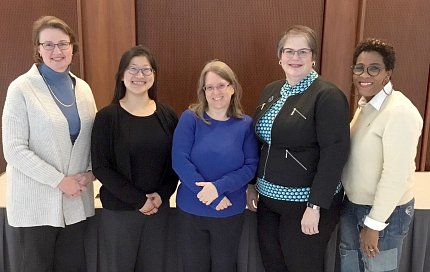CELI Holds Project Symposium

Photo: Chloe James
Developing meaningful and effective micro-learning videos for staff training and strategies for increasing diversity of NIH peer reviewers were two of the topics presented during the recent 2019 Cement Extramural Leadership Institute (CELI) Project Symposium. The symposium was both the culmination of a 3-month leadership program and a stand-alone training event for NIH employees.
CELI, which is coordinated through the NIH Office of Extramural Research, expands the decision-making and leadership skills of extramural staff. The 40 participants in the 2019 cohort heard from engaging leaders from within and outside NIH, who shared strategies and principles of effective management and leadership. Dr. Yvonne Maddox, vice president, Uniformed Services University; Dr. Lynn Goldman, dean, Milken Institute School of Public Health at George Washington University; Dr. Alison Cernich, NICHD deputy director; and NIH director Dr. Francis Collins were among the speakers.
Throughout the 10-week program, CELI participants worked in teams, reinforcing lessons learned as they conducted research and developed a proposal to address an extramural challenge.
Topics included:
- Peer Review 2030
- Strategies to Increase Diversity in NIH Peer Review
- Recommendations for Patient-Centered Disease Consortia
- Artificial Intelligence in Medicine and the Life Sciences: The Need for a Chain of Trust
- Risk and Opportunities of Science as a Global Enterprise
- Measuring Scientific Efficacy at NIH and Possible New Directions
- Advancing Research and Training Opportunities at Minority-Serving Institutions
- Microlearning Videos to Complement Staff Training
Each CELI group presented a proposal at the symposium.

Photo: Chloe James
The TV4PO group created and shared two videos for training program officials. Presenter Dr. Julio Aliberti, NIAID scientific review officer, explained, “Our two pilot micro-learning training videos show an improper and an appropriate response by a program official, [with] transition text and voiceovers, reinforcing correct NIH procedures for external stakeholder interactions.”
Another feature discussion was from the Diversity Warriors, who outlined four strategies to increase diversity in the NIH peer review process: communicate NIH’s commitment to diversity when recruiting reviewers; increase the representation of assistant professors or equivalent in peer review; increase the role of public representatives in peer review; and capture and utilize other domains of reviewer diversity and experience. These strategies, combined with ongoing efforts such as the NIH Early-Career Reviewer Program, can broaden the definition of diversity in peer review and increase the diversity of NIH review panels.
For details, visit https://stafftraining.intranet.od.nih.gov/cement-extramural-leadership-institute.
